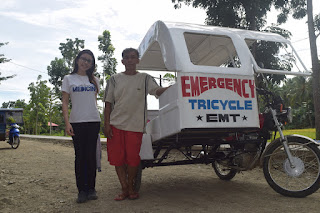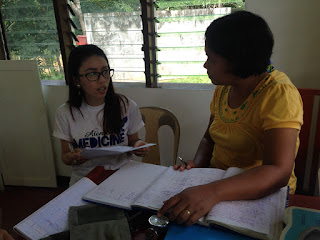Barangay
Goaw is located around 8 km away from the center of the municipality, where the
Rural Health Unit (RHU) and Liloy Integrated Health District Hospital (LIHDH)
are situated. The distance from such facilities, unequipped barangay health station
and lack of transport system in the community are the major barriers in health
access especially during emergencies where prompt treatment is imperative. The
lack of organized referral system in the community resulted in delays, which
eventually resulted to medical complications, even death. Both could have been
prevented if only immediate assessment, diagnosis and management were done.
The Barangay Health
Workers (BHW) and Barangay Health Emergency Response Team (BHERT) are trained
individuals for first aid. They serve as responders for the barangay together
with the Barangay Officials. The Local Disaster Risk Reduction and Management
Fund (LDRRMF), in coordination with the Philippine Red Cross, have spearheaded trainings
on Basic Life Support and First Aid. However, such trainings become ineffective
if not regularly conducted and if the skills are not put into practice. Also, knowledge
alone is not enough; the lack of medical equipment and resources limited the help
they can offer to those in need of emergency care.
The 4-year health plan,
therefore, envisions not only to equip the response team with the knowledge and
skills on emergency response, but also to provide financial allocation and
political support that will ensure the sustainability of the project in the
years to come.
·
First Aid and BLS Training. In
coordination with Philippine Red Cross Dipolog Chapter, the organized Barangay
Health Emergency Response Team (BHERT) and Barangay Health Workers (BHWs)
already underwent training on First Aid last October 2014. To prevent knowledge
decay, a refresher course was done on September 27, 2016, where Basic Life
Support (BLS) and basic first aid measures of common cases in the barangay were
discussed. In addition, the Local Disaster Risk Reduction and Management Fund
(LDRRMF) allocated financial support for yearly First Aid and BLS trainings among
responders of each barangay in the municipality. The training yielded positive result with an increase in number of emergency responders
with basic first aid and BLS knowledge and skills from 42.8% to 85.7%.
· “Emergency
Tricycle (EmT)". It is intended to be the primary mode of
transportation for trauma, obstetric and medical emergencies. This is a project
proposed to the Local Government Unit (LGU) in solving two of the problems of
the community when accidents and emergencies
occur-- distance to the RHU/hospital and availability of transportation. Also
known as Habal-Habal Ambulance by the
locals, the EmT was patterned from the motorcycle ambulance advocated by the
Federal Ministry of Health and was then modified by the Municipal Engineer in a
way that can withstand rough terrain and narrow roads common in the community.
· Evaluation of responded and referred emergency cases. Equipped
with knowledge and skills, the BHERT responds to the emergency cases in the
barangay and provides proper documentation and referral to the next level of
care. Headed by the barangay’s chairman on health, monthly monitoring of the
recorded cases is done. In the month of October, 18 out of 18(100%) of the
emergency case (17 medical, 1 obstetrics) in the barangay was properly recorded,
responded and referred to the Rural Health Unit.
With
the construction of the Emergency Tricycle (EmT), the problems on distance and lack
of transportation for emergency cases were overcome. The Barangay Health
Emergency Response Team will be able to provide quality care services for their
constituents. With the regular trainings they receive from reputable
organizations, it is assured that their knowledge and skills in basic first aid
management will improve the primary health care services in the community.
Intended for municipal-wide adoption, the response and
referral transport system in the barangay serves as a pilot study and will then
undergo modifications depending on the outcome of its first year of
implementation. Hence, the impact of the projects initiated in the barangay
will not only benefit a small group of people but the municipality as a whole.






